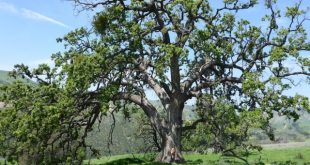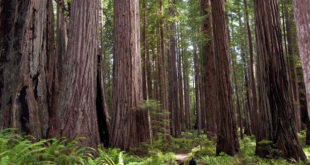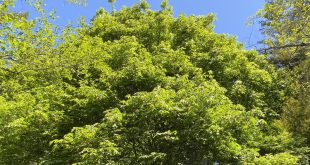Family PINACEAE
Sometimes the most interesting thing about a species of tree is where it occurs or, more precisely, where its occurrence ends. Such is the case with western hemlock, which reaches the southernmost limit of its 2000-mile range from north in Alaska to right here in the Gualala River watershed. Populations living at the end of a species’ range have a special significance and raise important questions about conservation, as we discuss below. In California, western hemlock is a tree of the temperate coastal forests. It thrives where atmospheric and soil moisture is high which means that, in our watershed, it is found in the company of coast redwoods primarily along bottom lands near the river and its tributaries. [Photo:1]

Description
Western Hemlock is a shade-tolerant conifer that can reach heights of 200 feet or more, though in our watershed, it is usually of more modest height. Its leader tip characteristically droops which can help distinguish it from the tops of other conifers emerging from the forest around it. [Photo: 2] Hemlock foliage is a soft yellow green, and the boughs hang in graceful sprays. [Photos: 3,4].
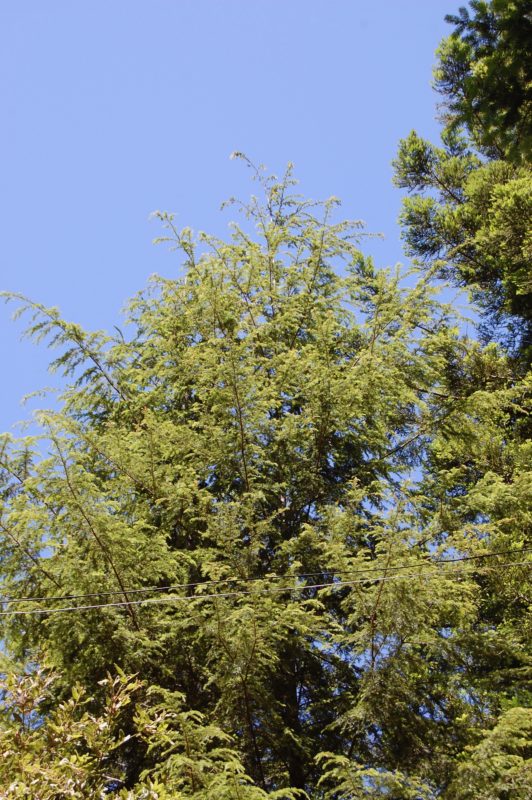


The species name, “heterophylla,” means “different leaves” and refers to the fact that the branches bear needles of different lengths emerging from the branch in an irregular way. [Photo: 5].
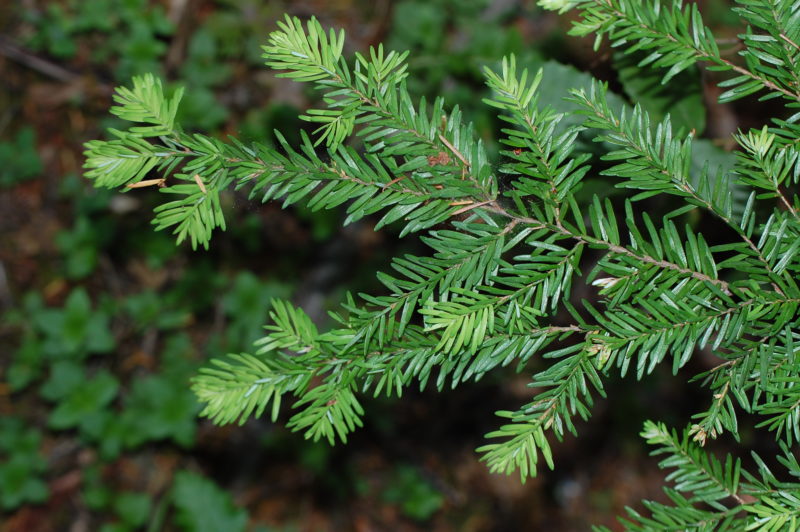
Compare the photo of western hemlock needles with those of grand fir, Douglas fir, and coast redwood which are other conifers which occur in our watershed. [Photos: 6,7,8]
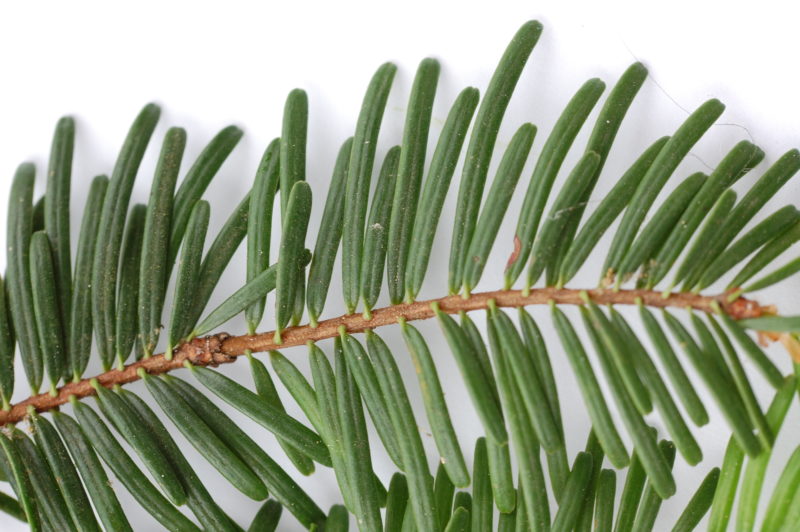
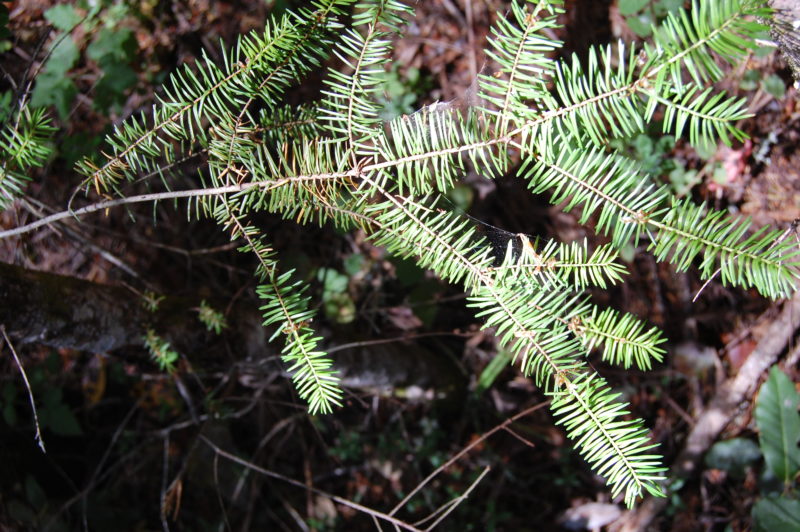
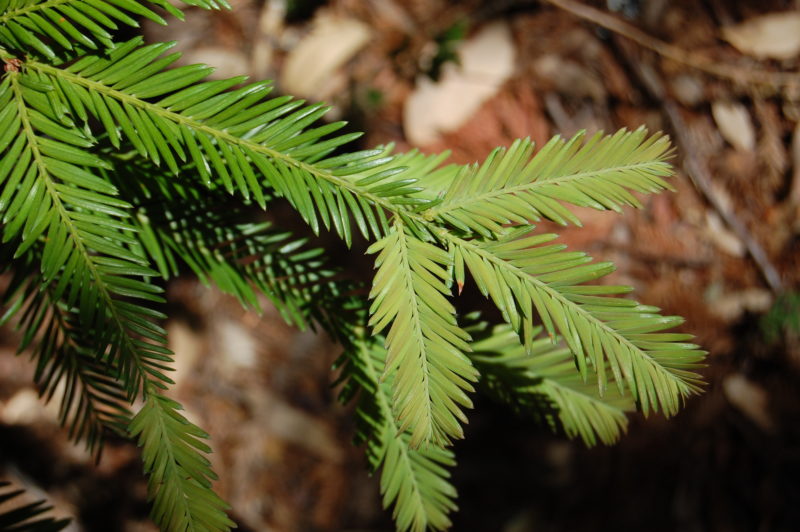
The bark of hemlock saplings is thin, flat, reddish, and often covered with mosses and liverworts. [Photo: 9] As the tree matures, the bark thickens into more elongate, narrow plates. [Photo: 10]
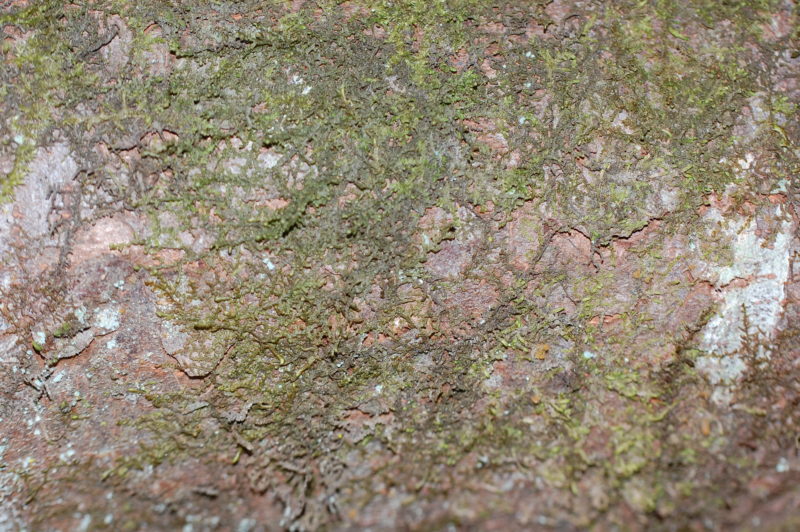
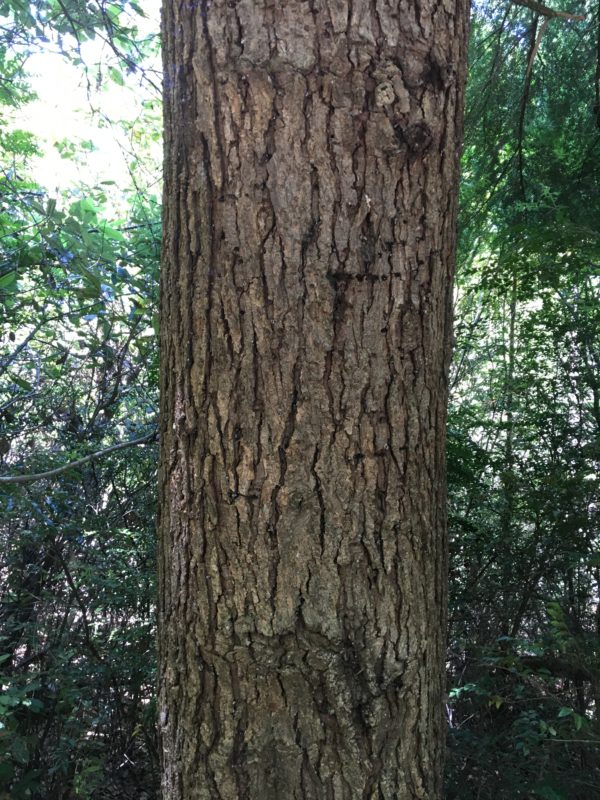
Thanks to its shade tolerance, the trunks of western hemlocks grow erect rather than twisting or leaning to reach sunlight. [Photo: 11]. At the base of the tree there are characteristic buttresses that help stabilize it. These can become enormous over time. [Photos: 12, 13]
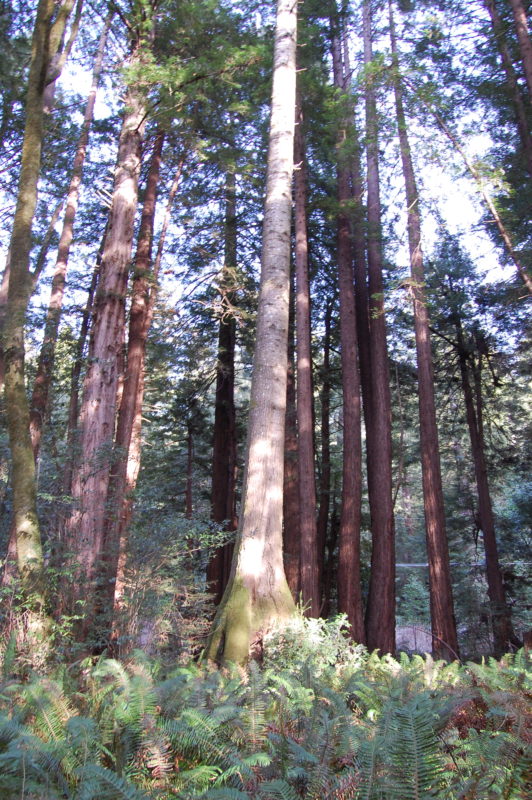


At about 25-30 years of age hemlocks become reproductively mature. Cone initiation begins in early summer, but pollination does not take place until spring of the following year. Each tree bears both male and female flowers. In May the female flowers are pollinated by the wind, and the seed cones begin to develop as small, green egg-shaped structures. By late summer, the seeds within the cones have matured and in early fall, the cones begin to release abundant seeds. The cones are small—1 to 1 1/2 inches— and the tiny winged seeds are about 1/8 of an inch. [Photo: 14].
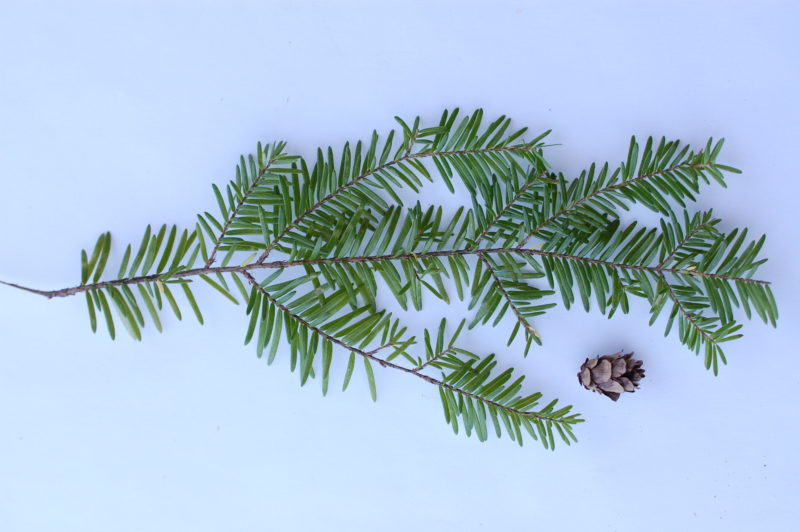
The hemlock cones possess an important adaptation: the scales can open to release seeds on warm days throughout the year and close when the weather isn’t optimal. In this manner, the seeds can take advantage of the entire year, not just a single brief growing season. Often cones remain on the tree from the previous year which helps in spotting hemlocks among the foliage of other conifers. [Photos: 15, 16 ].
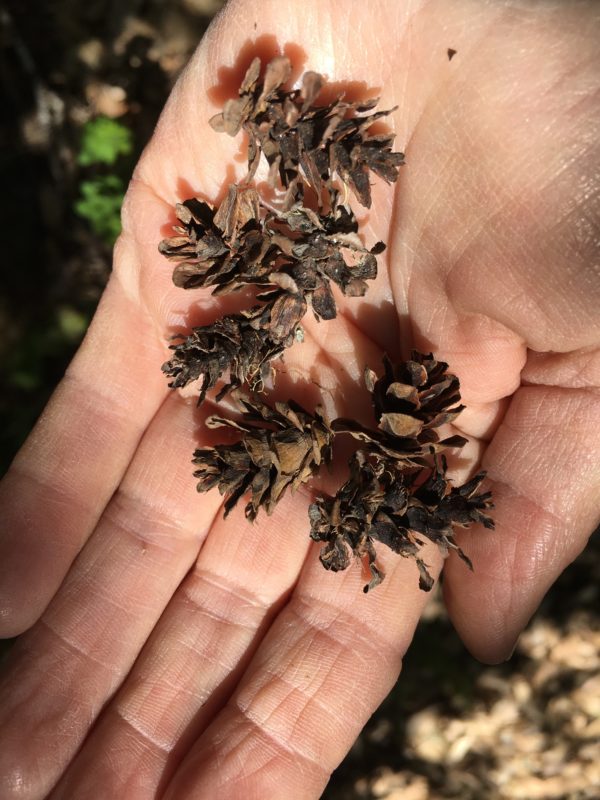
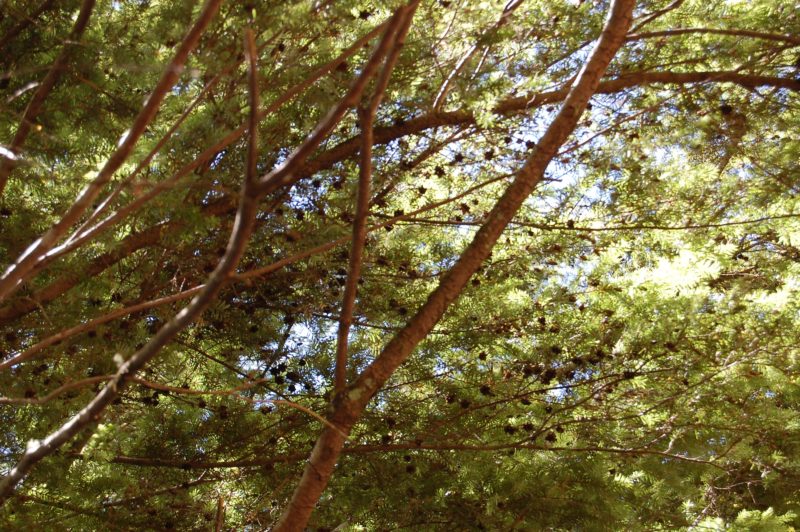
Western hemlock has a very shallow root system. It is easily damaged by wind storms that break off leader tips or cause entire trees to topple. [Photo: 17. ]. Shallow roots make it also susceptible to drought when the water table drops. Wildfires—even light, fast-moving fires—can damage and kill hemlocks, either directly or by wounding the tree and making it susceptible to fungal infection and insect infestation. The trees do not re-sprout after fire, but new trees will rapidly colonize burned over areas.

Life History
Western hemlocks often begin life on a decaying log on the forest floor where tiny winged seeds have rained down from a parent tree. Those seeds that are fortunate to land on rotting logs germinate in a rich planting medium of organic matter while safely perched above the forest floor where they might otherwise be buried in debris. As the nurse log slowly decays, it provides nutrients and moisture for mosses, lichens, and fungi which in turn support the growth of hemlock seedlings which can often sprout in a row along the log forming a colonnade. Over time, their roots wrap over the log and extend into the soil of the forest floor.
This mature hemlock is growing out of a rotting redwood log—note the redwood sprout emerging on the right. [Photo: 18] Conditions under old-growth redwoods along the river were once wet enough to produce old-growth hemlocks. Notice how the buttresses of this tree have grown over what was once a log or perhaps a stump but which has now fully rotted away. [Photo: 19].
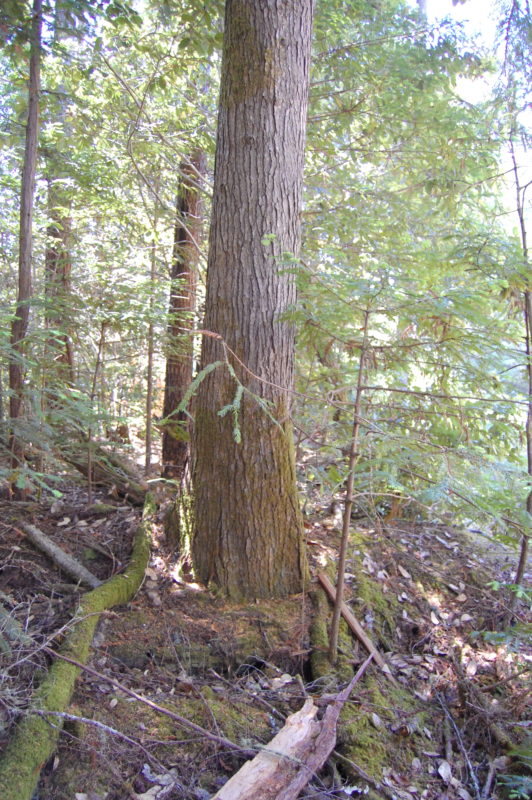
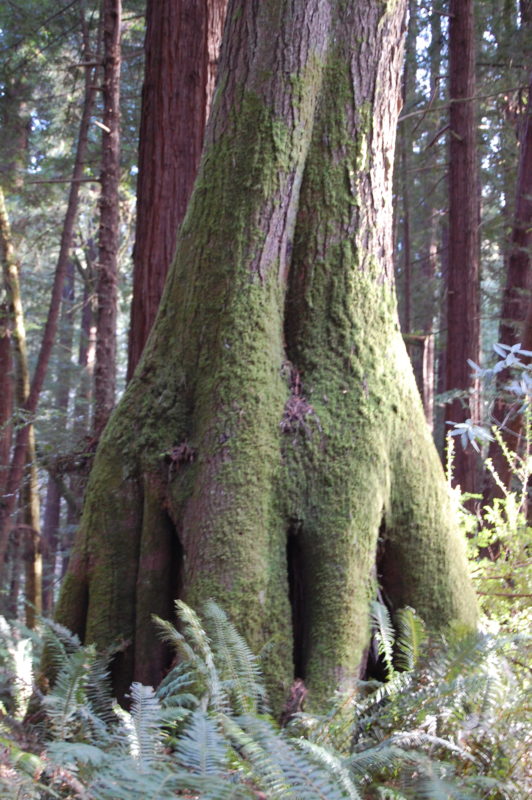
In the extremely wet temperate rainforest of Washington, western hemlock (the Washington state tree!) finds its most optimal habitat. The nurse log that once supported this grand colonnade of western hemlock and sitka spruce has now fully decomposed. [Photo: 20]

Unlike many species, hemlock saplings manage to survive in deep shade for many years, growing very slowly. Once the canopy opens, the tree can accelerate its growth tremendously. Early research comparing growth rates of old-growth hemlocks that grew up shaded by Douglas firs with that of second-growth hemlocks in unshaded conditions found that the old-growth trees grew extremely slowly reaching an average diameter of only 2 inches and a height of just 38 feet within the first 50 years. By comparison, second-growth trees achieved a diameter of 12.7 inches and a height of 96 feet on average in the same period. This capacity to survive deep shade for decades and to accelerate growth when released is one of the key adaptations of the species. [Photos 21, 22]
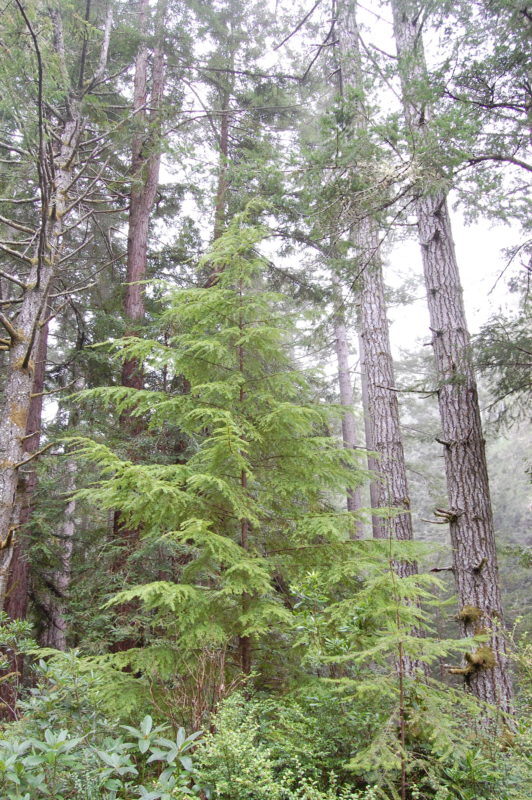
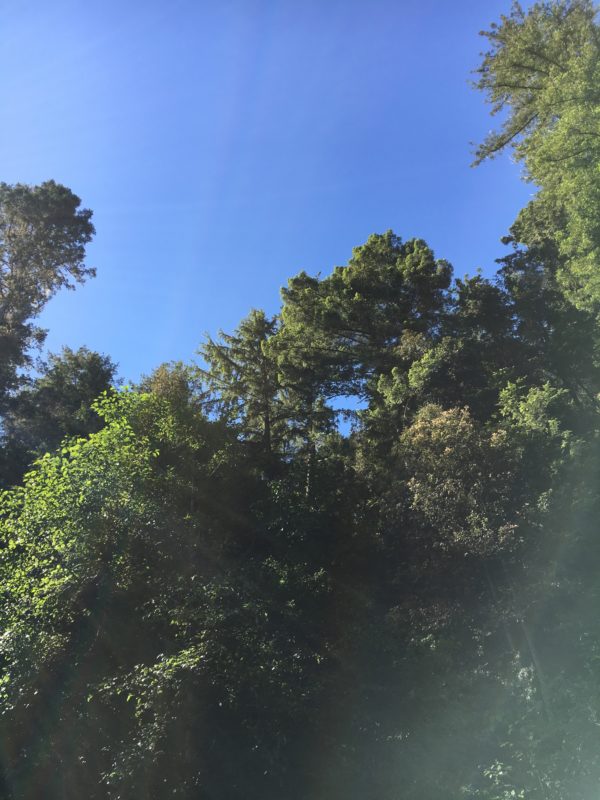
Ecology
Western hemlock has rich partnerships with many different mycorrhizal fungi associated with its roots which help the tree absorb minerals and water. Of these many fungi, several of the edible mushroom species known to associate with western hemlock are Pacific Golden Chanterelle (Cantharellus formosus) and Admirable Bolete (Aureoboletus mirabilis).
Other fungal species attack and parasitize live hemlocks, causing rot in different tissues (crown, trunk or roots). Dyer’s polypore (Phaeolus schweinitzii) is a common parasitic fungus found on hemlocks. [Photo: 23]. The heartwood of hemlock isn’t protected by pitch as in other conifers and is therefore more susceptible to rot. As the tree decays, the loose bark and excavated hollows provide important roosting habitat to bats and nest sites for cavity-nesting birds and mammals.
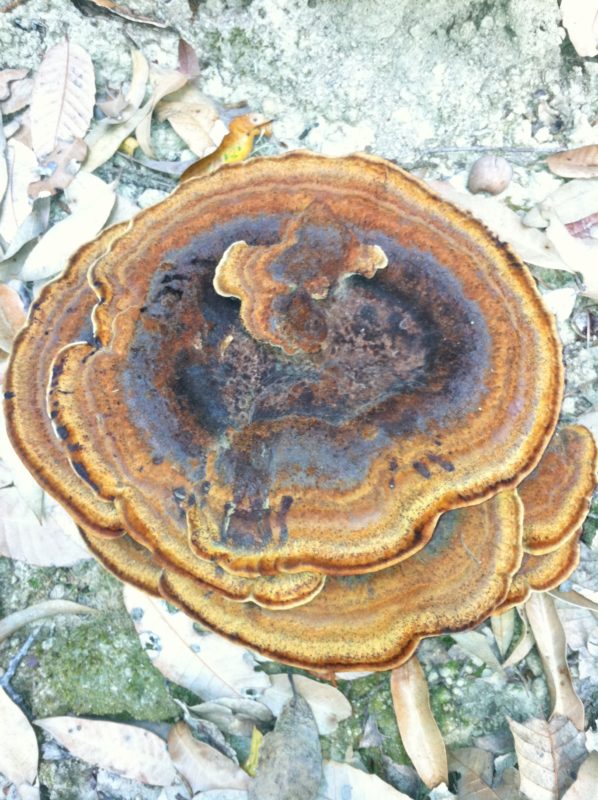
Pine siskins, crossbills, chickadees and deer mice are some of the species that eat hemlock seeds. Deer browse the foliage and twigs. A number of moth species in the family Geometridae (their larvae are commonly known as inch-worms or loopers) use the tree species as a larval host plant and in high concentrations can damage the trees, though this is more likely to happen where the population of hemlocks is more concentrated. These caterpillars are an important protein source for baby birds.
Uses of Western Hemlock
Western hemlock wood is used chiefly for pulp, railroad ties, and construction lumber. The bark has a high amount of tannin and was formerly used in the tanning industry to tan hides. Native Americans used it for the same purpose and also chewed the inner bark like gum.
Status of Western Hemlock in the Watershed
Information on Species Occurrences
While western hemlock thrives in the central portions of its range north of California, we don’t know much about the numbers that grow here in our watershed. Without good data, it’s impossible to know whether the occurrences here are maintaining the status quo. Best et al. (1996) considered the species rare in Sonoma County, though based on the map of collection sites, it’s clear that there was little to no collecting from the Gualala River watershed. One impediment to developing good data is the fact that 99% of the watershed land is in private hands, and, so, accurate surveys either aren’t performed or are not available to the public. It’s likely that there are more hemlocks growing among the coast redwoods on the private industrial timber lands owned by the Mendocino Redwood Company and Gualala Redwood Timber, though not in the economically valuable numbers found to the north.
We know that, based on recent botanical surveys, western hemlock has been reported by The Conservation Fund to occur in the Gualala Forest in the northeastern portion of the watershed but not in the Buckeye Forest farther south. In the coastal drainage contiguous to the watershed, hemlock has been reported from The Sea Ranch Native Plant database as occurring on the ridge, which is private land. There are also reports of hemlock from Salt Point State Park to the south.
The species does not occur on any existing public land in the watershed. However recently Save the Redwoods League purchased a tract of old-growth redwood property near Haupt Creek which will eventually be a public park. It’s possible that western hemlock could be found there.
Fortunately, there are a few places where the public can see western hemlocks in the watershed. Along the main stem of the river upstream from the bridge over Highway 1, there are hemlocks growing among the redwoods on the north-facing side of the river. [Photo: 24] These can be seen while floating along the river or from the opposite bank at the private campground. They also occur in scattered locations along Skaggs Springs Road. [Photo: 25]
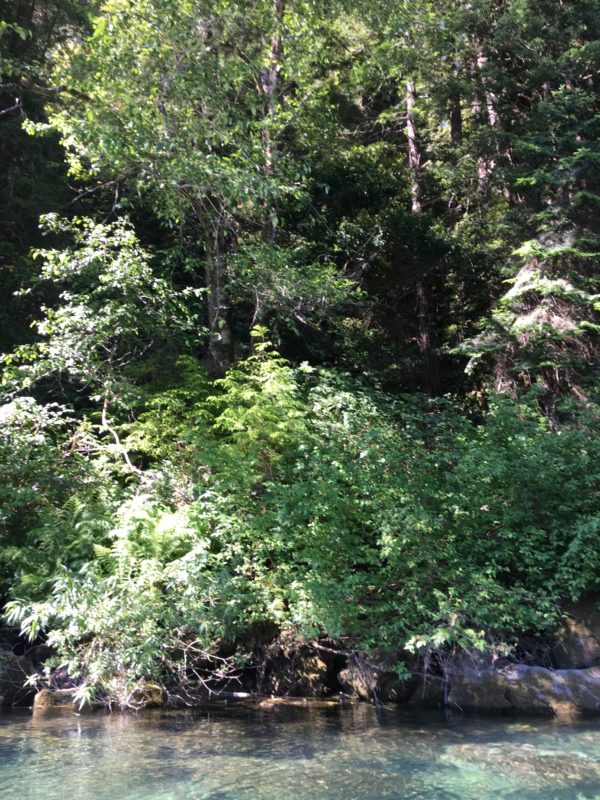
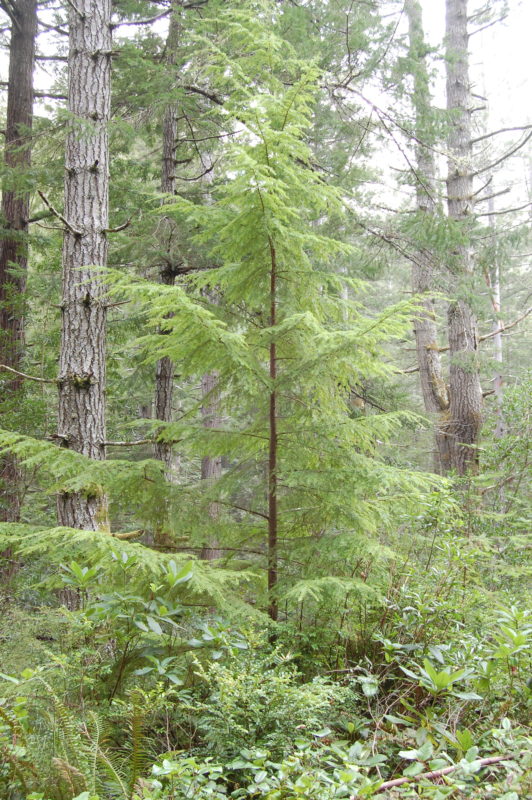
Perhaps the best place to view them up close is a “hotspot” for hemlock along Fish Rock Road within a quarter mile in either direction of the transfer station. It’s possible to park there along the roadside and walk on either side of the road where both saplings and mature trees are growing. This site, despite the depressing presence of litter from the transfer station, is rich in species and a good place to see Giant Chinquapin as well. [Photos: 26, 27]
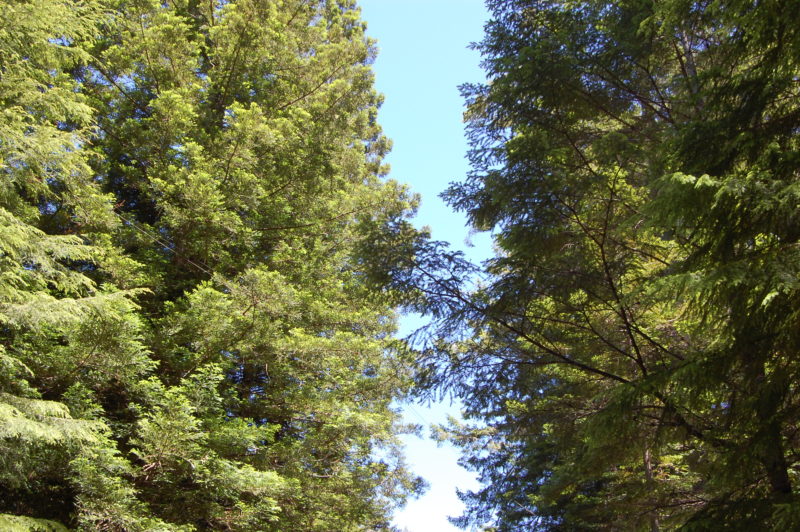
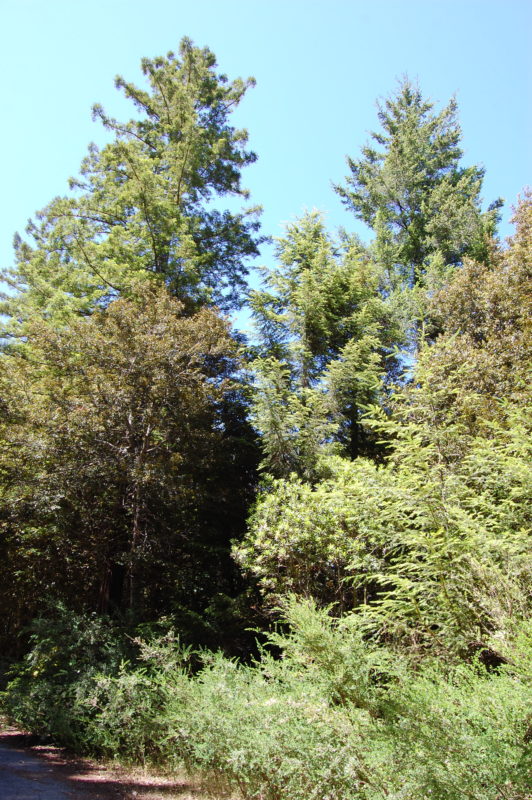
Mapping Projects Where Western Hemlock Occurs in California
Vegetation in Sonoma County was recently mapped (through LIDAR and ground mapping) in a massive project called Sonoma Veg Map. The results of that project show that western hemlock is not a significant component of any of the forest habitats that were sampled. Authors of the study concluded that western hemlock—which might be expected to appear as a species occurring with redwood—was not an important co-occurring species here.
The reason given is that here in the central redwood region the more drought-tolerant tanoak has replaced western hemlock due to reduced rainfall. Some of the 52 redwood forest sample sites were located in the Gualala River watershed, but, of course, the entire watershed was not mapped.
Previous mapping of vegetation in far northern coastal California where western hemlock is more common than here revealed that of the 11 forest types (vegetation ecologists call these “alliances”) in which western hemlock occurs, 9 of them are listed as rare statewide. The alliance in which western hemlock is the dominant species is becoming increasingly rare. The authors concluded, “Stands [of the Western Hemlock Alliance] on commercial timberlands have been logged. Unlogged stands on federal land warrant protection; they are the southernmost examples of an extensive forest type in the Pacific Northwest.”
Conservation Questions about Western Hemlock
Plant conservation scientists are increasingly interested in the identification of locally rare plants. One particular type of local rarity is found in plant species that are common throughout their entire range but are rare at the limits of the range. These plant populations are called peripheral populations and their conservation is paradoxical. On the one hand they are at increased risk for local extirpation because they are smaller and more isolated than populations at the core of the range. They also are more genetically and ecologically divergent, and herein lies the paradox: these local populations have evolved genetic responses to tough conditions that populations at the core of the range don’t have to face. That means that they possess genetic “tools” that might help save the entire species in the face of large-scale threats that could cause extinction. Here in the Gualala River watershed at the extreme southern limit of the species the western hemlocks comprise a peripheral population.
Efforts should be directed toward identifying just how uncommon or rare hemlocks are in the watershed. The peripheral population of western hemlocks in the Gualala River watershed faces a variety of threats: not only is it apparently a small population, though exact numbers are not known; it is also fragmented. There are no occurrences on public lands where they could be more easily monitored and protected. Logging in the watershed poses multiple threats. Western hemlock is a commercial timber species that likely occurs on private industrial lands where there is no protection. Sometimes hemlock trees are removed to promote the growth of more economically valuable trees. Large-scale timber harvest plans in the floodplain, where hemlock is most likely to occur, are also a serious threat. The current practice of clear cutting exposes the soil to higher temperatures and drying conditions even as our climate is becoming warmer and drier. Finally, many of the western hemlocks occur along roadways where there is enough opening of the canopy to release them. However, there they grow under power lines where they can be limbed up and topped and along roadsides where the vegetation is mowed or cut for fire purposes. [Photos: 28, 29]
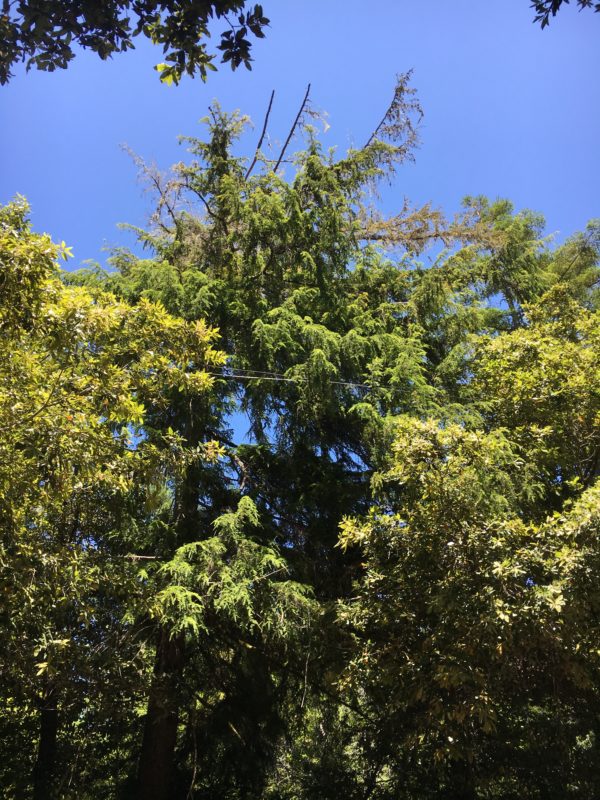
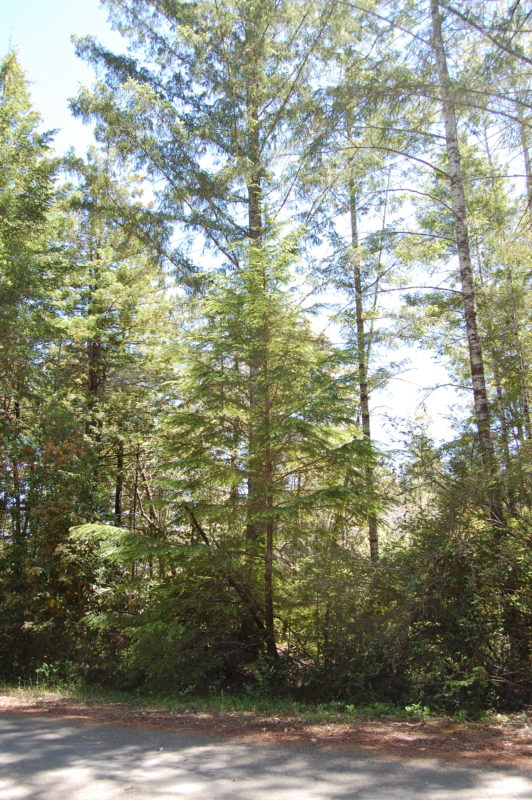
It is clear that, at the least, western hemlock should be on a watch list where the population can be inventoried and assessed. There are important questions to ask: what is the ratio of mature (seed-producing) trees to saplings? Are these seed-producing trees of sufficient quantity, health, and appropriate distribution to improve the chances of maintaining viable populations? And most important of all, what level of protection should be provided to them?
Here in the Gualala River watershed, there are too few western hemlocks to support commercial harvesting, so they have little economic value. On the other hand they add beauty, diversity, and grace to the forests and may someday hold the genetic key to protecting the species.
Selected Sources
Best, Catherine, John Thomas Howell, Walter and Irja Knight, and Mary Wells. 1996. A Flora of Sonoma County.
California Native Plant Society. 2018. Manual of California Vegetation.
Graves, Henry S. 1912. Silvicultural Leaflet 45. Western Hemlock, Tsuga heterophylla (Raf.) Sargent. USDA Forest Service.
Griffin, James R., and William B. Critchfield. 1972. The distribution of forest trees in California. Berkeley, California. USDA Forest Service.
Jepson, Willis Linn. 1910. The Silva of California. Memoirs of the University of California. Volume 2.
Kauffmann, Michael E. 2013. Conifers of the Pacific Slope: A Field Guide to the Conifers of California, Oregon, and Washington.
Klein, Anne, Todd Keeler-Wolf, and Julie Evens. 2015. Classification of the Vegetation Alliances and Associations of Sonoma County, California. Volume 2. Vegetation Descriptions.
Lanner, Ronald M. 2002. Conifers of California.
Leppig, Gordon, and Jeffrey W. White. 2006. “Conservation of Peripheral Plant Populations In California.” Madrono, Vol. 53, No. 3, pp. 264-274.
Rice, Barbara. 2017. Botanical Inventories of The Sea Ranch (Personal Communication).
Siegel, Noah and Christian Schwarz. 2016. Mushrooms of the Redwood Coast: A Comprehensive Guide to the Fungi of Coastal Northern California.
The Conservation Fund. 2014. Gualala River Forest Integrated Resource Management Plan.
The Conservation Fund 2017. Buckeye Forest Integrated Resource Management Plan.
United States Department of Agriculture. U.S. Forest Service. Fire Effects Information Service. Natural Resource Conservation Service.
All Photos by Laura Baker except Photo 20 taken by Rhiannon Boyle, licensed under Creative Commons. (Original caption “All in a Row.”)
 Friends of Gualala River Protecting the Gualala River watershed and the species living within it
Friends of Gualala River Protecting the Gualala River watershed and the species living within it
